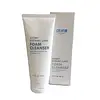What's inside
What's inside
 Key Ingredients
Key Ingredients

 Benefits
Benefits

 Concerns
Concerns

 Ingredients Side-by-side
Ingredients Side-by-side

Water
Skin ConditioningSodium Cocoyl Isethionate
CleansingGlycerin
HumectantSodium Methyl Cocoyl Taurate
CleansingCoco-Betaine
CleansingPotassium Cocoyl Glycinate
Potassium Benzoate
PreservativeSodium Chloride
MaskingPolyquaternium-67
Potassium Cocoate
EmulsifyingCitric Acid
BufferingFructooligosaccharides
HumectantSaccharide Hydrolysate
HumectantDisodium EDTA
Pullulan
1,2-Hexanediol
Skin ConditioningAllantoin
Skin ConditioningPanthenol
Skin ConditioningSea Water
HumectantSodium Acetate
BufferingButylene Glycol
HumectantChamomilla Recutita Flower Oil
MaskingCaprylic/Capric Triglyceride
MaskingBeta-Glucan
Skin ConditioningPhosphatidylcholine
EmulsifyingHyaluronic Acid
HumectantEthylhexylglycerin
Skin ConditioningCeramide NP
Skin ConditioningGlycine
BufferingHydrolyzed Hyaluronic Acid
HumectantGlutamic Acid
HumectantSerine
MaskingSodium Hyaluronate
HumectantLysine
Skin ConditioningAlanine
MaskingArginine
MaskingThreonine
Proline
Skin ConditioningWater, Sodium Cocoyl Isethionate, Glycerin, Sodium Methyl Cocoyl Taurate, Coco-Betaine, Potassium Cocoyl Glycinate, Potassium Benzoate, Sodium Chloride, Polyquaternium-67, Potassium Cocoate, Citric Acid, Fructooligosaccharides, Saccharide Hydrolysate, Disodium EDTA, Pullulan, 1,2-Hexanediol, Allantoin, Panthenol, Sea Water, Sodium Acetate, Butylene Glycol, Chamomilla Recutita Flower Oil, Caprylic/Capric Triglyceride, Beta-Glucan, Phosphatidylcholine, Hyaluronic Acid, Ethylhexylglycerin, Ceramide NP, Glycine, Hydrolyzed Hyaluronic Acid, Glutamic Acid, Serine, Sodium Hyaluronate, Lysine, Alanine, Arginine, Threonine, Proline
Glycerin
HumectantPotassium Myristate
EmulsifyingWater
Skin ConditioningButylene Glycol
HumectantPotassium Cocoyl Glycinate
Potassium Stearate
CleansingCocamidopropyl Betaine
CleansingMyristic Acid
CleansingSodium Methyl Cocoyl Taurate
CleansingPotassium Laurate
EmulsifyingPEG-40 Stearate
EmulsifyingLauric Acid
CleansingGlyceryl Stearate
EmollientPEG-100 Stearate
Parfum
MaskingStearic Acid
CleansingTocopheryl Acetate
AntioxidantCordyceps Sinensis Extract
AntioxidantPhellinus Linteus Extract
Skin ConditioningPhellinus Linteus/Rice Ferment Extract
EmollientPhellodendron Amurense Bark Extract
Skin ConditioningRheum Palmatum Root/Stalk Extract
AstringentScutellaria Baicalensis Root Extract
AstringentSophora Angustifolia Root Extract
Skin ConditioningAlthaea Officinalis Leaf/Root Extract
EmollientAnthemis Nobilis Flower Extract
MaskingFoeniculum Vulgare Leaf Extract
HumectantHouttuynia Cordata Extract
Skin ConditioningLavandula Angustifolia Flower
Skin ConditioningOcimum Basilicum Flower/Leaf Extract
TonicRosmarinus Officinalis Extract
AntimicrobialBeta-Glucan
Skin ConditioningTrisodium EDTA
Pyrus Malus Fruit Water
Masking1,2-Hexanediol
Skin ConditioningGlycerin, Potassium Myristate, Water, Butylene Glycol, Potassium Cocoyl Glycinate, Potassium Stearate, Cocamidopropyl Betaine, Myristic Acid, Sodium Methyl Cocoyl Taurate, Potassium Laurate, PEG-40 Stearate, Lauric Acid, Glyceryl Stearate, PEG-100 Stearate, Parfum, Stearic Acid, Tocopheryl Acetate, Cordyceps Sinensis Extract, Phellinus Linteus Extract, Phellinus Linteus/Rice Ferment Extract, Phellodendron Amurense Bark Extract, Rheum Palmatum Root/Stalk Extract, Scutellaria Baicalensis Root Extract, Sophora Angustifolia Root Extract, Althaea Officinalis Leaf/Root Extract, Anthemis Nobilis Flower Extract, Foeniculum Vulgare Leaf Extract, Houttuynia Cordata Extract, Lavandula Angustifolia Flower, Ocimum Basilicum Flower/Leaf Extract, Rosmarinus Officinalis Extract, Beta-Glucan, Trisodium EDTA, Pyrus Malus Fruit Water, 1,2-Hexanediol
 Reviews
Reviews

Ingredients Explained
These ingredients are found in both products.
Ingredients higher up in an ingredient list are typically present in a larger amount.
1,2-Hexanediol is a synthetic liquid and another multi-functional powerhouse.
It is a:
- Humectant, drawing moisture into the skin
- Emollient, helping to soften skin
- Solvent, dispersing and stabilizing formulas
- Preservative booster, enhancing the antimicrobial activity of other preservatives
Beta-Glucan is a polysaccharide. It can be derived from the cell walls of seaweed, oats, yeast, and fungi. It hydrates the skin and helps boost your skin's natural barrier.
As an antioxidant, beta-glucan helps fight free-radicals. Free-radicals are molecules that may damage your skin cells, such as pollution.
Studies show this ingredient may be an effective wrinkle reducer as it can deeply penetrate into skin. It has also been show to help with wound healing.
Learn more about Beta-GlucanButylene Glycol (or BG) is used within cosmetic products for a few different reasons:
Overall, Butylene Glycol is a safe and well-rounded ingredient that works well with other ingredients.
Though this ingredient works well with most skin types, some people with sensitive skin may experience a reaction such as allergic rashes, closed comedones, or itchiness.
Learn more about Butylene GlycolGlycerin is already naturally found in your skin. It helps moisturize and protect your skin.
A study from 2016 found glycerin to be more effective as a humectant than AHAs and hyaluronic acid.
As a humectant, it helps the skin stay hydrated by pulling moisture to your skin. The low molecular weight of glycerin allows it to pull moisture into the deeper layers of your skin.
Hydrated skin improves your skin barrier; Your skin barrier helps protect against irritants and bacteria.
Glycerin has also been found to have antimicrobial and antiviral properties. Due to these properties, glycerin is often used in wound and burn treatments.
In cosmetics, glycerin is usually derived from plants such as soybean or palm. However, it can also be sourced from animals, such as tallow or animal fat.
This ingredient is organic, colorless, odorless, and non-toxic.
Glycerin is the name for this ingredient in American English. British English uses Glycerol/Glycerine.
Learn more about GlycerinPotassium Cocoyl Glycinate is an amino acid-based surfactant and cleaning agent. This ingredient can be derived from animals or plants. It may also be synthetically created from fatty acids of the coconut and glycine.
Potassium Cocoyl Glycinate is a gentle surfactant. Surfactants help gather the dirt, oil, and other pollutants from your skin to be rinsed away. It is a mild cleanser and naturally produces foam.
This gentle cleansing and foaming ingredient is known for leaving a smooth feeling in skin and hair. It is made using coconut oil.
According to the manufacturer, it is soluble in water and has resistance to hard water, acid, and alkali.
Due to its coconut base, it may not be Malassezia folliculitis safe.
Learn more about Sodium Methyl Cocoyl TaurateWater. It's the most common cosmetic ingredient of all. You'll usually see it at the top of ingredient lists, meaning that it makes up the largest part of the product.
So why is it so popular? Water most often acts as a solvent - this means that it helps dissolve other ingredients into the formulation.
You'll also recognize water as that liquid we all need to stay alive. If you see this, drink a glass of water. Stay hydrated!
Learn more about Water